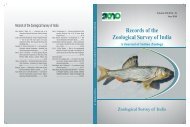Vol. 111 - Part I - Zoological Survey of India
Vol. 111 - Part I - Zoological Survey of India
Vol. 111 - Part I - Zoological Survey of India
Create successful ePaper yourself
Turn your PDF publications into a flip-book with our unique Google optimized e-Paper software.
18 Rec. zool. Surv. <strong>India</strong><br />
parts <strong>of</strong> Bihar and Orissa (Plate-I). The forests contain<br />
common species to both the northern and southern<br />
tracts and similar to vegetation found in Nayagarh<br />
district (Chaudhuri et al., 2007). There are many low<br />
hills at many parts <strong>of</strong> Puri district have good contact<br />
grows and raised garden <strong>of</strong> betel leaf which are the<br />
principal cash crop <strong>of</strong> many villages. Polang tree was<br />
seen at many villages whose seeds produced principal<br />
illuminant before kerosene came to use.<br />
METHODS<br />
The survey methods applied in Puri and Khurda<br />
districts were the same that was adopted in Nayagarh<br />
district survey (Chaudhuri et al., 2007). The survey was<br />
conducted on road sides, villages, towns and forests.<br />
The roadside surveys were made by using a slow<br />
moving vehicle while forest roads and trails were<br />
surveyed both by vehicle and on foot. Transect and<br />
point methods were adopted to locate monkeys in the<br />
forests and hills. The transect method in the forest path<br />
was accomplished by slow walking and waiting for 5-6<br />
minutes in every 200 m for visual and auditory signals<br />
for presence <strong>of</strong> monkeys (Southwick et al., 1961). The<br />
point method was adopted in hills where elevation<br />
exceeds 200 m and above. In other areas total count<br />
and sweep sampling techniques were used to estimate<br />
the primate population.<br />
Four surveys were conducted in these two districts<br />
from 2002 to 2004 during summer and winter months<br />
and the data collected during summer 2004 survey is<br />
presented here, when the two districts were resurveyed<br />
so as to avoid any duplication <strong>of</strong> monkey counts. The<br />
survey was conducted in the forenoon (0700-1130 hrs.)<br />
and afternoon (1500-1800 hrs.) depending upon<br />
available sunlight. A total <strong>of</strong> 1600 hrs. was conducted<br />
for in the field survey. About 2400 km2 area was<br />
surveyed which was 40% <strong>of</strong> the total geographical area<br />
<strong>of</strong> the study districts. The monkey groups when<br />
located, their social composition, habitat, inter-intra<br />
group interactions were recorded. The individuals <strong>of</strong> a<br />
group were broadly classified, for both the monkey<br />
species, as adult males, adult females, juveniles and<br />
infants. Adult males and adults females were determined<br />
depending upon their body size and age. Juveniles were<br />
those more than one year or less than three years old<br />
and infants were those carried by mothers, pre-weaned<br />
and less than one year old.<br />
RESULT<br />
A total <strong>of</strong> 2400 km2 area was surveyed which<br />
comprised about 38% <strong>of</strong> the total geographical area <strong>of</strong><br />
Puri and Khurda districts. Eighteen groups <strong>of</strong> rhesus<br />
monkey and 110 groups <strong>of</strong> Hanuman langur were<br />
recorded. The Hanuman langurs were mostly sighted<br />
in the villages and forests while rhesus monkeys were<br />
mainly observed in the forests.<br />
RHESUS MONKEY<br />
Altogether 18 rhesus monkey groups <strong>of</strong> 501<br />
individuals comprising 61 adult males; 224 adult females;<br />
100 juveniles and 116 infants were observed (Table-1)<br />
(Plate-I). The distribution <strong>of</strong> these monkeys is shown<br />
in Fig. 1. The group’s size varied from 5 to 52 individuals<br />
excluding Jagannath temple group in Puri town, which<br />
consisted <strong>of</strong> 134 monkeys. The Jagannath temple<br />
monkeys were distributed in more than one group, but<br />
identification <strong>of</strong> the groups was not possible due to<br />
close association and constant overlapping. The mean<br />
group size was 27.8 ± 7.06 <strong>of</strong> which 3.39 ± 0.76 was<br />
adult males, 12.44 ± 2.58 was adult females, 5.5 ± 2.23<br />
was juveniles and 6.4 ± 1.73 was infants (Table-1). This<br />
provides a population estimate <strong>of</strong> 0.0075 groups/km2 and 0.20 individuals/km2 .<br />
Out <strong>of</strong> 501 monkeys, the population composed <strong>of</strong><br />
12.18% adult males; 44.71% adult females; 19.96%<br />
juveniles and 23.15% infants. About 51.7% adult<br />
females were carrying infants. The adult males and adult<br />
females ratio was 1 : 3.6 and adult females and juveniles<br />
and infants ratios were 1 : 0.44 and 1 : 0.5 respectively.<br />
The 18 rhesus groups were observed in 4 habitats—<br />
villages, forest, temples and towns. Five temple groups<br />
were recorded with 234 monekys; forests contained 214<br />
individuals in 9 groups; 3 groups with 48 monkeys were<br />
counted in the villages and a town group with 5<br />
monkeys was recorded. The mean density <strong>of</strong> the habitat<br />
categories is shown in Fig. 1.<br />
The undivided Puri district was first surveyed by<br />
<strong>Zoological</strong> <strong>Survey</strong> <strong>of</strong> <strong>India</strong> team in 1978 under a DST<br />
(Tiwari & Mukherjee, 1992); the said report <strong>of</strong> the<br />
survey did not mention districtwise population. The<br />
Nayagarh district primate survey, which was a part <strong>of</strong><br />
the then Puri district, was published by Chaudhuri et<br />
al., 2007.
















